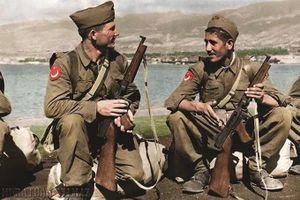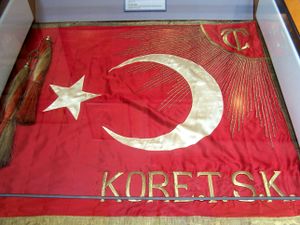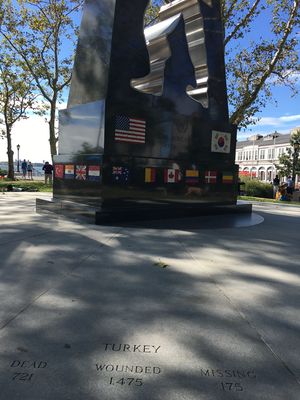اللواء التركي في الحرب الكورية
| Turkish Brigade | |
|---|---|
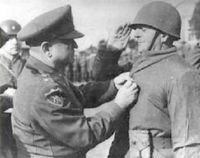 Turkish Brigade commander General Tahsin Yazıcı receiving the Silver Star from Lieutenant General Walton Walker (December 15, 1950). | |
| نشطة | 1950–1960 |
| البلد | |
| الولاء | |
| الفرع | Army |
| النوع | Infantry Brigade |
| الحجم | 14,936 (over duration of the conflict)[1] |
| جزء من | US 25th Infantry Division |
| الكنية | North Star |
| الاشتباكات | Korean War |
| التكريمات | Distinguished Unit Citation (United States) Presidential Unit Citation (Korea) |
| فـُضت | 1960 |
| القادة | |
| أبرز القادة | Brigadier General Tahsin Yazıcı (1950 – November 16, 1951) Assistant: Celâl Dora Chief of Operations: Faik Türün Namık Arguç (-August 20, 1952) Assistant: Nuri Pamir (June 5, 1952 †.[2]) Sırrı Acar (July 6, 1953) |
The Turkish Brigade (code name North Star, تركية: Şimal Yıldızı[3] or Kutup Yıldızı[4]) was a Turkish Army Infantry Brigade that served with the United Nations Command during the Korean War between 1950 and 1953. Attached to the U.S. 25th Infantry Division, the Turkish Brigade fought in several actions and was awarded Unit Citations from Korea and the United States after fighting in the Kunuri Battle.[5] The Turkish Brigade developed a reputation for its fighting ability, stubborn defense, commitment to mission, and bravery.
Background
On 29 June 1950 the Republic of Turkey replied to the United Nations Resolution 83 requesting military aid to South Korea, following the attack by North Korea on 25 June. The cable stated: "Turkey is ready to meet his responsibilities." On 25 July 1950 Turkey decided to send a brigade of 5,000 troops comprising three infantry battalions, an artillery battalion and auxiliary units, to fight under UN Command against North Korea and subsequently the People's Republic of China. Turkey was the second country to answer the UN call, after the United States.[6]
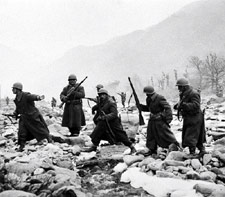
Three different Turkish Brigades served in the Korean War. The core of the 1st Turkish Brigade was the 241st Infantry Regiment based at Ayaş, which was supplemented with volunteers to raise it to brigade level. Brigadier General Tahsin Yazıcı, a veteran of the Gallipoli Campaign, commanded the 1st Brigade.[8]
The 1st Turkish Brigade consisted of three battalions, commanded by Major Imadettin Kuranel, Major Mithat Ulunu, and Major Lutfu Bilgon. The Turkish Armed Forces Command (TAFC) was a regimental combat team with three infantry battalions, along with supporting artillery and engineers. It was the only brigade-sized unit attached permanently to a U.S. division throughout the Korean War.
Brigadier General Tahsin Yazici was highly regarded in the Turkish military establishment. He stepped down a rank in order to command the first contingent of Turks in the Korean War. While there were cultural and religious differences between Turkish and American troops, both were disciplined forces capable of adapting. However, there was a language barrier that was more difficult to overcome.[9] General Yazici did not speak English, and Americans had overlooked the difficulty the language barrier would present.
The brigade had a full turnover after a period of one year's service. During the service of the 3rd Brigade in 1953, the Korean Armistice was signed. Thereafter, Turkey continued maintaining forces at full brigade level for another seven years, in accordance with United Nations agreements. Kenan Evren, the seventh President of the Republic of Turkey, served in the Brigade from 1958 until 1959.
The advance party of the Turkish Brigade arrived in Pusan on 12 October 1950. The main body arrived five days later, October 17 from the eastern Mediterranean port of Iskenderun, Turkey, and the brigade went into bivouac near Taegu where it underwent training and received U.S. equipment. The brigade was attached to the U.S. 25th Infantry Division.
Composition
The Turkish Armed Forces Command (TAFC) was a regimental combat team with three infantry battalions, along with supporting artillery and engineers. The three battalions were commanded by Major Imadettin Kuranel, Major Mithat Ulunu, and Major Lütfü Bilgon. It was the only brigade-sized UN unit attached permanently to a U.S. division throughout the Korean War.
Losses
Overall losses for the Turkish Brigade in Korea was 721 killed in action, 2,111 wounded and 168 missing.[5] Among the losses is the lone Turkish pilot, Muzaffer Erdönmez, who piloted a US B-26 and was shot down over Wonch Ang-nı while bombing the railroad tracks.[10] A total of 14,936 men served in the brigade between 1950–1953[1] with about 5,455 soldiers in Korea at any one time.[11] The United Nations Memorial Cemetery in Busan, South Korea is the burial place for 462 of those casualties.[12] Two memorials to the Turkish soldiers are at the cemetery.[13][14]
Popular culture
In 1954, a Turkish film bearing the operation code name of the Turkish Brigade (Şimal Yıldızı), directed by Atıf Yılmaz and starring Ayhan Işık, which praised the deeds of the unit was released.[15]
The Turkish Brigade is featured in the Unification Church-funded 1982 film Inchon, which inaccurately depicts the Turkish Brigade as being involved in the Battle of Inchon (in reality the Brigade did not arrive until the month after the battle). Gabriele Ferzetti plays the commander of the Brigade.[بحاجة لمصدر]
7th President of Turkey, Kenan Evren had served in Korea in Turkish Brigade, 1958-1959.
The 2017 Turkish film Ayla: The Daughter of War is based on the true story of a young war orphan nursed back to health from near-death by a sergeant in the Turkish Brigade but torn apart from him when he was unable to take her back to Turkey at the end of the war, and their reunion sixty years later.[16]
See also
References
- ^ أ ب Timmons, Robert. "Allies To Honor Each Nation's Korean War Veterans". Archived from the original on 2007-07-16. Retrieved 2009-04-15.
- ^ UNMCK, Nuri Pamir
- ^ Şimal Yıldızı, Rahim Er, 21 September 2009, Türkiye
- ^ Kutup Yıldızı – Kore Savaşı'nın 50. Yıldönümü ("North Star: the 50th Anniversary of the Korean War", TRT İzmir, Director: Ismail Ragıp Geçmen, 2000)
- ^ أ ب Evanhoe, Ed. "The Turkish Brigade". Archived from the original on 2008-10-02. Retrieved 2008-09-29.
- ^ Department of Defense. "Allied Forces in the Korean War". Archived from the original on 2007-07-16. Retrieved 2008-09-29.
- ^ Bevin Alexander photo collection http://bevinalexander.com/korea/korean-war-photos.htm
- ^ Turkish General Headquarters Military History Department Official Publications No: 7. Turkish Military Forces Korean War Operations (language Turkish).
{{cite book}}: CS1 maint: numeric names: authors list (link) - ^ historynet. "Korean War:1st Brigadeś Baptism of Fire". Retrieved 2016-11-04.
- ^ http://www.hvkk.tsk.tr/tr/IcerikDetay.aspx?ID=40&IcerikID=92
- ^ Walker, Jack D. "A brief account of the Korean War". Retrieved 2007-08-15.
- ^ UN Memorial Cemetery (Official)
- ^ "South Koreans, allies pay tribute to Turkish war effort". Daily News. Pakistan Defence. June 27, 2010.
- ^ UNMCK: Turkish Memorial I; UNMCK: Turkish Memorial II
- ^ Şimal Yıldızı, Sinematürk
- ^ "'Ayla,' a movie based on a heart-breaking 65-year-old real-life story". korea.net. 2 May 2017. Retrieved 27 August 2017.
- Appleman, Roy E. (2008). Disaster in Korea: The Chinese Confront MacArthur. Vol. Volume 11 of Texas A & M University military history series: Texas A and M University (illustrated ed.). Texas A&M University Press. ISBN 160344128X. Retrieved 18 April 2014.
{{cite book}}:|volume=has extra text (help) - Blair, Clay (2003). The Forgotten War: America in Korea, 1950–1953 (illustrated, reprint ed.). Naval Institute Press. ISBN 1591140757. Retrieved 18 April 2014.
- Blair, Clay (Dec 12, 1987). The forgotten war: America in Korea, 1950. Times Books. ISBN 0812916700. Retrieved 18 April 2014.
- Leckie, Robert (1996). Conflict: The History of the Korean War, 1950–53 (illustrated, reprint ed.). Da Capo Press. ISBN 0306807165. Retrieved 18 April 2014.
- Leckie, Robert (1962). Conflict: The history of the Korean War 1950–1953. New York: G. P. Putnam's Sons. Archived from the original on Feb 19, 2008.
Further reading
- Sŏ, Sŏk-pong (2007). Brother Nations, Korea and Turkey: a history of Turkish soldiers' participation in the Korean War. Seoul: Ministry of Patriots' and Veterans' Affairs. OCLC 243703768.
وصلات خارجية
- CS1 maint: numeric names: authors list
- Pages using Lang-xx templates
- Articles with unsourced statements from April 2013
- CS1 errors: extra text: volume
- Brigades of Turkey
- Military units and formations of Turkey in the Korean War
- Korean War
- United Nations contingents in Korea
- Military units and formations established in 1950
- Military units and formations disestablished in 1960
- Military units and formations of the Cold War
- Brigades of Korean War
